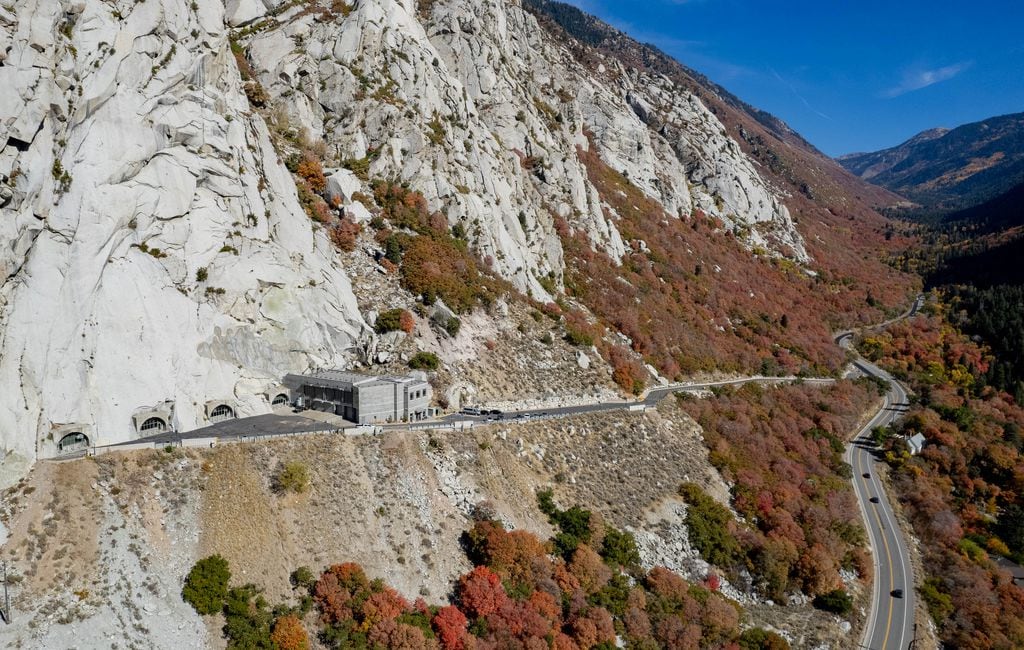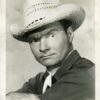LDS Church’s Granite Mountain vault is in proposed path of Little Cottonwood Canyon gondola
![]()
LDS Church’s Granite Mountain vault is in proposed path of Little Cottonwood Canyon gondola
Utah will need to buy or secure land agreements from The Church of Jesus Christ of Latter-day Saints and the federal government before it begins construction on a gondola to Snowbird and Alta.

(Francisco Kjolseth | The Salt Lake Tribune) The Granite Mountain Records Vault, a large archive owned by The Church of Jesus Christ of Latter-day Saints, on Thursday, Oct. 20, 2022. Portions of the land owned by the church may be needed to be acquired in order to build the Little Cottonwood Canyon gondola.
| Nov. 25, 2022, 5:00 a.m.
| Updated: 5:42 a.m.
While it will take years before skiers could be gliding through the skies of Little Cottonwood Canyon on a taxpayer-funded gondola, the Utah Department of Transportation will need to work out numerous land deals to make the controversial gondola a reality.
While much of the land needed to build the 22 proposed towers up the canyon is owned by the federal government, and will require navigating a mogul field of bureaucracy to transfer, one of Utah’s most influential institutions also owns land that the state will need to build the massive lift — The Church of Jesus Christ of Latter-day Saints.
According to plans in UDOT’s draft environmental impact statement (EIS) — which was made public in August — a tower for the proposed gondola would be situated just below the church’s secretive Granite Mountain Records Vault.
3
The facility houses the “world’s largest collection of genealogical records,” and it was built in 1965 to protect important records for the church, according to the LDS Church’s website.
The gondola tower would be situated between the canyon’s roadway and a parking lot for the Granite Mountain Records Vault, potentially giving gondola riders an aerial view of the facility’s entrance. The tower would be 164 feet tall and require a quarter-acre plot.

(Francisco Kjolseth | The Salt Lake Tribune) The entrance to the Granite Mountain Records Vault in Little Cottonwood Canyon.
Report an ad
Another UDOT record indicates 5.39 acres of the church’s land could be impacted via aerial easement, showing just how much impact a gondola tower could have on the church property. An aerial easement is an agreement where a property owner would retain the land itself, but another entity, like UDOT, would have access to the area above the land. The EIS details how far the aerial easements would extend.
In other words, gondola cables and cars would be hovering over 5.39 acres of church land, so long as the church agrees with the current plans.
A spokesperson for the LDS Church declined to comment on a potential land sale to the state or if it would approve an aerial easement.
Other Utah faith organizations, like the Catholic Diocese of Salt Lake City and the Episcopal Diocese of Utah, have spoken out against the project.
In September, Jean Hill — director of the Catholic Diocese’s Office of Life, Justice & Peace — told Fox 13, “The gondola is not an option for the poor and using that kind of state funding, for an option that will not benefit anyone who is low income, seems like a pretty poor use of taxpayer funds to us.”
The local Catholic Diocese also encouraged Catholics to weigh in on the proposal during UDOT’s public comment period, according to Fox 13.
Little Cottonwood Canyon is a special place for the LDS Church, as the stones that built the Salt Lake Temple were cut near the canyon’s mouth. Beginning in 1860, large wagons and oxen — and later trains — moved granite blocks from Little Cottonwood to what is now Temple Square, according to the church.
And the LDS church isn’t the only mogul that UDOT will need to navigate.
U.S. Forest Service
The largest owner of land for potential gondola towers is the federal government, as much of the canyon is a part of the Uinta-Wasatch-Cache National Forest and is maintained by the U.S. Forest Service.
According to a list of property impacts in the draft EIS, the federal government owns 4.698 acres of land where the proposed gondola’s stations and towers would be built.
In total, the gondola would require 22 towers and three loading stations — one at the mouth of the canyon and stations at Snowbird and Alta ski resorts. The UDOT plans also calls for two angle stations, which turn the direction of gondola cars.
Months before UDOT released their decision, Snowbird quietly bought two parcels of land totaling 4.86 acres where the “Gondola Alternative B” base station and a 2,500 stall parking garage would be located. Snowbird bought the land in the hopes of securing the viability of the gondola as an option for the canyon.
(Francisco Kjolseth | The Salt Lake Tribune) Fall color in Little Cottonwood Canyon on Wednesday, Oct. 19, 2022.
Lance Kovel, a special projects coordinator with the Uinta-Wasatch-Cache National Forest, said the Forest Service has been in the loop with UDOT for several years.
“UDOT engaged us basically at the beginning of their EIS process,” Kovel told The Salt Lake Tribune. “So we have been intimately involved with (UDOT) since 2018, coordinating on this project mostly on a weekly basis.”
Kovel, who is also the UDOT liaison for the Uinta-Wasatch-Cache National Forest, said the Forest Service has incorporated their analysis and concerns into the draft EIS, which the Forest Service requires before making land use decisions.
He added that, as of now, “there’s nothing that the Forest Service sees currently that would prohibit us from issuing a special use permit.”
However, Kovel noted that, like UDOT, the Forest Service is still in the process of reviewing public comments, and those comments could necessitate additional analysis or study.
UDOT could acquire the land outright, or it could agree to an easement or special-use permit. Either way, the process needs federal approval.
“With an easement or special-use permit, the USDA Forest Service would retain all ownership rights to the land, and UDOT would be authorized to own and operate the Selected Alternative,” the draft EIS says.
How UDOT could acquire gondola land
In written statements, Josh Van Jura, the project manager for the Little Cottonwood EIS, said the gondola project would first need to be funded before property acquisition could begin.
The project — which is estimated to cost taxpayers around $500 million — has plenty of detractors who don’t want to see it built, but the gondola has support from the person who’d ultimately sign off on it, Gov. Spencer Cox.
In October, Cox said he supported the idea of a gondola through the 8-mile-long canyon, though state lawmakers would have to decide on whether or not to provide funding for the project. If they do, UDOT has options.
The department can acquire property in different ways. One way is through temporary construction easements, which Van Jura said are essentially renting a piece of land during the construction phase.
Another means of acquisition is a perpetual easement, which is where a property owner still owns their land, but UDOT would have long-term rights to access and use the land. UDOT can also outright buy a property, which is called a full-fee acquisition.
(Francisco Kjolseth | The Salt Lake Tribune) Traffic in Little Cottonwood Canyon last month.
UDOT also has a final way to get land, though it’s the most controversial — the state can acquire property eminent domain, where the government has the ability to take land in exchange for fair compensation. However, that’s not an option on which UDOT wants to rely.
“Eminent domain is always a last resort,” Van Jura told The Tribune.
UDOT also needs to make agreements with landowners for aerial easements, ensuring the gondola cars can legally soar through the skies of the canyon.
What’s next?
Following the August draft’s release, UDOT opened a public comment period that lasted 45 days. In that time, the department received thousands of comments, which have since been made public.
UDOT’s Little Cottonwood Canyon EIS website says those working on the project are reviewing those comments.
After their review, the state will submit a record of decision, which will finalize their recommendation on how best to address transportation issues in the canyon.
That decision is slated to be published by the end of Utah’s ski season.
Editor’s note • This story is available to Salt Lake Tribune subscribers only. Thank you for supporting local journalism.

Donate to the newsroom now. The Salt Lake Tribune, Inc. is a 501(c)(3) public charity and contributions are tax deductible
Report an ad
IN CASE YOU MISSED IT
PREMIUMOne crop uses more than half of Utah’s water. Here’s why.Here’s what Utah Starbucks workers want from their customersPREMIUMIs pushing for change within the LDS Church a ‘tactic of Satan’? A top leader thinks so.
FROM THE WEB
- Diabetes Is Not From Sweets! Meet The Main Enemy Of Diabetesdiabets.live | Sponsored
- New Camera Makes Doorbell Cams ObsoleteBest Tech Trend | Sponsored
- Hands Down! The World’s Healthiest BreakfastKa’Chava | Sponsored
- Kia – Brand New and AffordableAll Things Auto | Sponsored
- Older Men Are Using This For Their Manhood HereTupi Tea | Sponsored
- Accidental Bloopers That Became Iconic MomentsDefinition | Sponsored
- [Photos] Octomom’s 8 Are All Grown Up – Look What Happened To Them12Up | Sponsored
- 20 Photos of Meghan Markle From Before She Was a RoyalDefinition | Sponsored
- [Pics] Jeff Bezos’ Private Jet Puts Air Force One To ShameDefinition | Sponsored
- Most Affordable Camper VansCamper Vans Warehouse | Sponsored
- Here Are 23 of the Coolest Gifts in 2022Best Tech Trend | Sponsored
- [Gallery] The House Where Kat Timpf Lives at 33 Is Hard to Believehttps://lifeindigo.com/ | Sponsored
- Controversial Magazine Covers That People RegretTheFinancialSavvy | Sponsored
THE LATEST
Suspect in the killing of radio host Gaby Ramos apprehended in Mexico
Boise State’s Green accounts for 5 TDs in win over Utah State
Bagley Cartoon: Influencers
Utah football’s Tavion Thomas ends college career, turns focus to NFL draft, East-West Shrine Bowl
Judge overturns Utah death sentence case, citing misconduct by Provo police, prosecutors after 1985 killing
The TribUte newsletter: How will history remember this Utah football team?
CONNECT
SUBSCRIPTIONS
- Subscribe to print + digital
- Subscribe to digital only
- Free digital for print subscribers
- Email newsletters
- Login to your print account
- Login to your digital account
- Subscription FAQs
- Help and contact info
- Gift Subscriptions
ABOUT US
- History and mission
- Our nonprofit model
- Board and advisers
- Officers and staff
- First Amendment Society
- Donors and tax filing
- Privacy policy
- California privacy
- Editorial policies and ethics
MORE
- Advertise with us
- Legal notices
- Store
- Podcasts
- Archives
- Story tip line
- Support The Tribune
- Donate
- Cookie Preferences
- Commenting Policy
Report a missed paper by emailing subscribe@sltrib.com or calling 801-237-2900
For e-edition questions or comments, contact customer support 801-237-2900 or email subscribe@sltrib.com
sltrib.com © 1996-2022 The Salt Lake Tribune. All rights reserved.
javascript:falsejavascript:false































![Lieutenant-Colonel Robert Rogers (7 November 1731 – 18 May 1795) was a British Army officer and frontiersman. Born in Methuen, Massachusetts, he fought in King George’s War, the French and Indian War and the American Revolutionary War. During the French and Indian War, Rogers raised and commanded Rogers’ Rangers, a ranger unit trained for carrying out asymmetric warfare.[2][3](https://www.cowboyron.com/wp-content/uploads/2022/05/1262463_580743685323360_2133853937_o1-1-150x150.jpg)

















![Billie Joe Armstrong & Norah Jones – Silver Haired Daddy Of Mine [Music Video]](https://www.cowboyron.com/wp-content/uploads/2022/11/Al_St._John1-100x100.jpg)

























